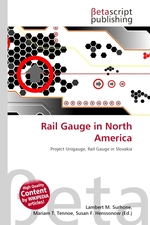Rail Gauge in North America
Lambert M. Surhone, Mariam T. Tennoe, Susan F. Henssonow
бумажная книга
High Quality Content by WIKIPEDIA articles! The vast majority of North American railroads are standard gauge. Exceptions include some streetcar, subway and rapid transit systems and some narrow gauge lines particularly in the West, e.g. the isolated White Pass and Yukon Route system, and the former Newfoundland Railway. As well as the usual reasons for having one gauge i.e. being able to operate through trains without transfer arrangements, the North American continent-wide system of freight car interchange with rolling stock having the same standard gauge, couplings, and air brakes meant that individual companies could minimise their rolling stock requirements by borrowing from other companies. Peak demand periods varied over the continent, with seasonal requirements e.g. for grain shipments occurring at different times in different areas so that freight cars could be redistributed to cover peaks as required.
Данное издание не является оригинальным. Книга печатается по технологии принт-он-деманд после получения заказа.


